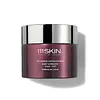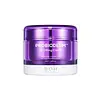What's inside
What's inside
 Key Ingredients
Key Ingredients

 Benefits
Benefits

 Concerns
Concerns

 Ingredients Side-by-side
Ingredients Side-by-side

Water
Skin ConditioningIsopropyl Myristate
EmollientCaprylic/Capric Triglyceride
MaskingGlycerin
HumectantPEG-40 Hydrogenated Castor Oil
EmulsifyingGlyceryl Stearate
EmollientPEG-100 Stearate
Acetyl Cysteine
AntioxidantEscin
TonicSodium Ascorbyl Phosphate
AntioxidantSodium Hyaluronate
HumectantCistus Incanus Flower/Leaf/Stem Extract
Skin ConditioningYeast Extract
Skin ConditioningSoy Isoflavones
Skin ConditioningBeta-Sitosterol
Emulsion StabilisingAesculus Hippocastanum Seed Extract
Skin ConditioningAloe Barbadensis Leaf Extract
EmollientCentella Asiatica Extract
CleansingGlycosphingolipids
EmollientCarbomer
Emulsion StabilisingHydroxyacetophenone
AntioxidantOlea Europaea Fruit Oil
MaskingOryza Sativa Bran Oil
EmollientPhenoxyethanol
Preservative1,2-Hexanediol
Skin ConditioningCaprylyl Glycol
EmollientSodium Hydroxide
BufferingPolyglyceryl-6 Laurate
EmulsifyingPolyglyceryl-10 Oleate
Skin ConditioningPhenylpropanol
MaskingLecithin
EmollientSorbitan Palmitate
EmulsifyingParfum
MaskingWater, Isopropyl Myristate, Caprylic/Capric Triglyceride, Glycerin, PEG-40 Hydrogenated Castor Oil, Glyceryl Stearate, PEG-100 Stearate, Acetyl Cysteine, Escin, Sodium Ascorbyl Phosphate, Sodium Hyaluronate, Cistus Incanus Flower/Leaf/Stem Extract, Yeast Extract, Soy Isoflavones, Beta-Sitosterol, Aesculus Hippocastanum Seed Extract, Aloe Barbadensis Leaf Extract, Centella Asiatica Extract, Glycosphingolipids, Carbomer, Hydroxyacetophenone, Olea Europaea Fruit Oil, Oryza Sativa Bran Oil, Phenoxyethanol, 1,2-Hexanediol, Caprylyl Glycol, Sodium Hydroxide, Polyglyceryl-6 Laurate, Polyglyceryl-10 Oleate, Phenylpropanol, Lecithin, Sorbitan Palmitate, Parfum
Water
Skin ConditioningLactobacillus Ferment Lysate
Skin ConditioningGlycerin
HumectantDipropylene Glycol
HumectantCaprylic/Capric Triglyceride
MaskingCetearyl Alcohol
EmollientLimnanthes Alba Seed Oil
Skin ConditioningGlycereth-26
HumectantVinyldimethicone
Hydrogenated Poly(C6-14 Olefin)
EmollientHydrogenated Polydecene
EmollientPolyglyceryl-3 Methylglucose Distearate
EmulsifyingGlyceryl Stearate
EmollientBetaine
HumectantPolyglycerin-3
Humectant1,2-Hexanediol
Skin ConditioningCetearyl Olivate
Pentylene Glycol
Skin ConditioningPhytosteryl/Behenyl/Octyldodecyl Lauroyl Glutamate
Skin ConditioningLactobacillus Ferment
Skin ConditioningFructooligosaccharides
HumectantFructan
Skin ConditioningInulin
Skin ConditioningPanthenol
Skin ConditioningBeta-Glucan
Skin ConditioningAdenosine
Skin ConditioningSaponins
CleansingSoluble Proteoglycan
Skin ConditioningNonapeptide-1
Skin ConditioningAcetyl Tetrapeptide-9
Skin ConditioningAcetyl Tetrapeptide-5
HumectantAcetyl Hexapeptide-1
Skin ConditioningAcetyl Hexapeptide-8
HumectantPalmitoyl Tripeptide-8
Skin ConditioningDipeptide Diaminobutyroyl Benzylamide Diacetate
Skin ConditioningCopper Tripeptide-1
Skin ConditioningTripeptide-1
Skin ConditioningPalmitoyl Tetrapeptide-7
Skin ConditioningPalmitoyl Tripeptide-1
Skin ConditioningPalmitoyl Tripeptide-5
Skin ConditioningPalmitoyl Pentapeptide-4
Skin ConditioningPalmitoyl Hexapeptide-12
Skin ConditioningPentapeptide-3
Skin ConditioningHexapeptide-9
Skin ConditioningOligopeptide-2
Skin ConditioningMalt Extract
Skin ProtectingDioscorea Japonica Root Extract
Skin ConditioningElaeis Guineensis Oil
EmollientBehenyl Alcohol
EmollientSorbitan Olivate
EmulsifyingButyrospermum Parkii Butter
Skin ConditioningDipentaerythrityl Hexahydroxystearate/Hexastearate/Hexarosinate
Skin ConditioningHydrogenated Rapeseed Oil
EmollientHydroxyacetophenone
AntioxidantSodium Polyacrylate
AbsorbentHydrolyzed Jojoba Esters
Skin ConditioningPEG-100 Stearate
Ethylhexylglycerin
Skin ConditioningAcrylates/C10-30 Alkyl Acrylate Crosspolymer
Emulsion StabilisingXanthan Gum
EmulsifyingTromethamine
BufferingButylene Glycol
HumectantMaltodextrin
AbsorbentCyanocobalamin
Skin ConditioningCetyl Ethylhexanoate
EmollientPropanediol
SolventCetearyl Glucoside
EmulsifyingAlgin
MaskingSodium Stearoyl Glutamate
CleansingTocopherol
AntioxidantBiosaccharide Gum-4
Skin ConditioningMineral Salts
Skin ConditioningHydrolyzed Corn Starch
HumectantSodium Phosphate
BufferingCaprylyl Glycol
EmollientSucrose
HumectantDextran
Disodium Phosphate
BufferingParfum
MaskingWater, Lactobacillus Ferment Lysate, Glycerin, Dipropylene Glycol, Caprylic/Capric Triglyceride, Cetearyl Alcohol, Limnanthes Alba Seed Oil, Glycereth-26, Vinyldimethicone, Hydrogenated Poly(C6-14 Olefin), Hydrogenated Polydecene, Polyglyceryl-3 Methylglucose Distearate, Glyceryl Stearate, Betaine, Polyglycerin-3, 1,2-Hexanediol, Cetearyl Olivate, Pentylene Glycol, Phytosteryl/Behenyl/Octyldodecyl Lauroyl Glutamate, Lactobacillus Ferment, Fructooligosaccharides, Fructan, Inulin, Panthenol, Beta-Glucan, Adenosine, Saponins, Soluble Proteoglycan, Nonapeptide-1, Acetyl Tetrapeptide-9, Acetyl Tetrapeptide-5, Acetyl Hexapeptide-1, Acetyl Hexapeptide-8, Palmitoyl Tripeptide-8, Dipeptide Diaminobutyroyl Benzylamide Diacetate, Copper Tripeptide-1, Tripeptide-1, Palmitoyl Tetrapeptide-7, Palmitoyl Tripeptide-1, Palmitoyl Tripeptide-5, Palmitoyl Pentapeptide-4, Palmitoyl Hexapeptide-12, Pentapeptide-3, Hexapeptide-9, Oligopeptide-2, Malt Extract, Dioscorea Japonica Root Extract, Elaeis Guineensis Oil, Behenyl Alcohol, Sorbitan Olivate, Butyrospermum Parkii Butter, Dipentaerythrityl Hexahydroxystearate/Hexastearate/Hexarosinate, Hydrogenated Rapeseed Oil, Hydroxyacetophenone, Sodium Polyacrylate, Hydrolyzed Jojoba Esters, PEG-100 Stearate, Ethylhexylglycerin, Acrylates/C10-30 Alkyl Acrylate Crosspolymer, Xanthan Gum, Tromethamine, Butylene Glycol, Maltodextrin, Cyanocobalamin, Cetyl Ethylhexanoate, Propanediol, Cetearyl Glucoside, Algin, Sodium Stearoyl Glutamate, Tocopherol, Biosaccharide Gum-4, Mineral Salts, Hydrolyzed Corn Starch, Sodium Phosphate, Caprylyl Glycol, Sucrose, Dextran, Disodium Phosphate, Parfum
 Reviews
Reviews

Ingredients Explained
These ingredients are found in both products.
Ingredients higher up in an ingredient list are typically present in a larger amount.
1,2-Hexanediol is a synthetic liquid and another multi-functional powerhouse.
It is a:
- Humectant, drawing moisture into the skin
- Emollient, helping to soften skin
- Solvent, dispersing and stabilizing formulas
- Preservative booster, enhancing the antimicrobial activity of other preservatives
This ingredient is an emollient, solvent, and texture enhancer. It is considered a skin-softener by helping the skin prevent moisture loss.
It helps thicken a product's formula and makes it easier to spread by dissolving clumping compounds.
Caprylic Triglyceride is made by combining glycerin with coconut oil, forming a clear liquid.
While there is an assumption Caprylic Triglyceride can clog pores due to it being derived from coconut oil, there is no research supporting this.
Learn more about Caprylic/Capric TriglycerideCaprylyl Glycol is a humectant and emollient, meaning it attracts and preserves moisture.
It is a common ingredient in many products, especially those designed to hydrate skin. The primary benefits are retaining moisture, skin softening, and promoting a healthy skin barrier.
Though Caprylyl Glycol is an alcohol derived from fatty acids, it is not the kind that can dry out skin.
This ingredient is also used as a preservative to extend the life of products. It has slight antimicrobial properties.
Learn more about Caprylyl GlycolGlycerin is already naturally found in your skin. It helps moisturize and protect your skin.
A study from 2016 found glycerin to be more effective as a humectant than AHAs and hyaluronic acid.
As a humectant, it helps the skin stay hydrated by pulling moisture to your skin. The low molecular weight of glycerin allows it to pull moisture into the deeper layers of your skin.
Hydrated skin improves your skin barrier; Your skin barrier helps protect against irritants and bacteria.
Glycerin has also been found to have antimicrobial and antiviral properties. Due to these properties, glycerin is often used in wound and burn treatments.
In cosmetics, glycerin is usually derived from plants such as soybean or palm. However, it can also be sourced from animals, such as tallow or animal fat.
This ingredient is organic, colorless, odorless, and non-toxic.
Glycerin is the name for this ingredient in American English. British English uses Glycerol/Glycerine.
Learn more about GlycerinGlyceryl Stearate is a mix of glycerin and stearic acid.
It is used to stabilize the mixing of water and oil ingredients. By preventing these ingredients from separating, it can help elongate shelf life. It can also help thicken the product's texture.
As an emollient, it helps soften skin and supports barrier-replenishing ingredients.
In cosmetics, Glyceryl Stearate is often made from vegetable oils or synthetically produced.
This ingredient may not be fungal-acne safe
Fun fact: The human body also creates Glyceryl Stearate naturally.
Learn more about Glyceryl StearateHydroxyacetophenone is antioxidant with skin conditioning and soothing properties. It also boosts the efficiency of preservatives.
This ingredient is not irritating or sensitizing.
Parfum is a catch-all term for an ingredient or more that is used to give a scent to products.
Also called "fragrance", this ingredient can be a blend of hundreds of chemicals or plant oils. This means every product with "fragrance" or "parfum" in the ingredients list is a different mixture.
For instance, Habanolide is a proprietary trade name for a specific aroma chemical. When used as a fragrance ingredient in cosmetics, most aroma chemicals fall under the broad labeling category of “FRAGRANCE” or “PARFUM” according to EU and US regulations.
The term 'parfum' or 'fragrance' is not regulated in many countries. In many cases, it is up to the brand to define this term.
For instance, many brands choose to label themselves as "fragrance-free" because they are not using synthetic fragrances. However, their products may still contain ingredients such as essential oils that are considered a fragrance by INCI standards.
One example is Calendula flower extract. Calendula is an essential oil that still imparts a scent or 'fragrance'.
Depending on the blend, the ingredients in the mixture can cause allergies and sensitivities on the skin. Some ingredients that are known EU allergens include linalool and citronellol.
Parfum can also be used to mask or cover an unpleasant scent.
The bottom line is: not all fragrances/parfum/ingredients are created equally. If you are worried about fragrances, we recommend taking a closer look at an ingredient. And of course, we always recommend speaking with a professional.
Learn more about ParfumPeg-100 Stearate is an emollient and emulsifier. As an emollient, it helps keep skin soft by trapping moisture in. On the other hand, emulsifiers help prevent oil and water from separating in a product.
PEGS are a hydrophilic polyether compound . There are 100 ethylene oxide monomers in Peg-100 Stearate. Peg-100 Stearate is polyethylene glycol ester of stearic acid.
Water. It's the most common cosmetic ingredient of all. You'll usually see it at the top of ingredient lists, meaning that it makes up the largest part of the product.
So why is it so popular? Water most often acts as a solvent - this means that it helps dissolve other ingredients into the formulation.
You'll also recognize water as that liquid we all need to stay alive. If you see this, drink a glass of water. Stay hydrated!
Learn more about Water